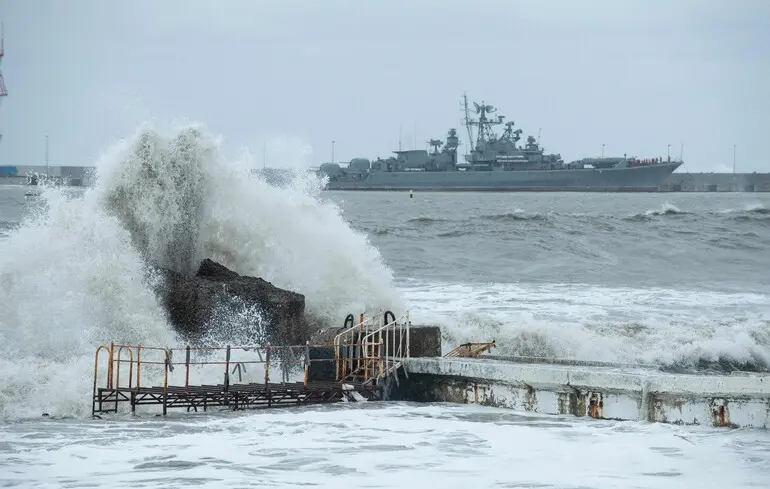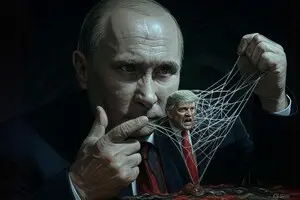Ukraine Must Take First Step To Take Back Crimea And Sea Of Azov, Without It Nothing Will Happen

When the past shoots at the future
During the shelling of Ukrainian cities on the night of April 6, Russia used Kalibr cruise missiles, installed on the ships of the aggressor's naval group in the Black Sea. As has been repeatedly noted by the Ukrainian side, Russia is not going to adhere to the Washington -initiated truce at sea. The agreement that was allegedly reached between Russia and the United States is interpreted in the Kremlin in a completely different way than the White House sees it.
Kyiv logically believes that the naval truce applies only to civilian shipping and does not apply to Russian warships and vessels. The Ukrainian Foreign Ministry explained that the movement of Russian ships beyond the eastern part of the Black Sea would be considered a threat to Ukraine's national security and a violation of the principle of free navigation. Under such circumstances, Kyiv will have the full right to destroy the aggressor's forces and means when they leave the quay wall in the eastern sector of the Black Sea, the Sea of Azov or anywhere else in the adjacent maritime zone of the occupied Crimean peninsula.
Whoever controls Crimea dominates the Black Sea. If Crimea is in the hands of the aggressor, the Black Sea automatically becomes a theater of war. A real truce at sea between Russia and Ukraine is possible only if Crimea is de-occupied and Ukraine regains control over the western coast of the Sea of Azov. In the pre-war period, Ukraine did not make enough efforts to implement the necessary set of measures to establish maritime borders and delimit the areas.
In the early 2000s, Russia imposed its vision of the UN Convention on the Law of the Sea on the Ukrainian leadership of the time, and on this basis, the Azov Sea became a “common sea of two states.” In reality, however, it was de facto controlled by Russia through an unequal treaty concluded in 2003.
Trading in other people’s territory
Reports that the Trump administration is considering the possibility of recognizing Crimea as Russian territory as part of some kind of a peace agreement have repeatedly appeared in the media. It has even been said that the White House has allegedly discussed a possible US appeal to the UN with a proposal to recognize Crimea as Russian territory at the international level. It is likely that the spread of such rumors is a component of Russian propaganda. However, there has been no refutation of the claims by the White House, and there is no mention of Secretary of State Mike Pompeo's Crimea Declaration from the first Trump presidency in Washington.
Most likely, the current US administration does not have a formed vision of security issues in the Azov-Black Sea basin, just as previous administrations did not have one. Therefore, in their view, Crimea and Azov are some kind of a “no man's land” without clear borders, for which Russia and Ukraine are fighting. This serves as a basis for “peacekeepers” from the banks of the Potomac to trade territory “for peace.” In their words it is necessary to recognize the existing territorial realities and that Ukraine should accept the loss of territories, as one notorious congresswoman of Ukrainian origin recently stated.
It is clear that we are talking primarily about land and the Russian-occupied territories in the south and east of Ukraine. However, we should not forget about the maritime spaces — about 100,000 square kilometers of the exclusive maritime economic zone and territorial sea in the Black Sea alone, which the aggressor considers its own, as well as in the Sea of Azov, which Russia already considers its own inland sea.
What needs to be done?
Back in 2018, a renowned Ukrainian diplomat Leonid Osavoliuk wrote an article The Siege of Azov, pointing out, among other things, the need to legislate for the existing state border between Ukraine and the Russian Federation in the Kerch Strait, to declare by law in the Black Sea the lateral line of demarcation between the territorial seas of Ukraine and the Russian Federation (the line of the state border) and to announce the coordinates of the median line in the Sea of Azov, which, until a bilateral agreement is concluded, serves as the demarcation line (the line of the state border) between Ukrainian and Russian waters.
In August 2024, experts from the Maritime Expert Platform, an informal association, drafted a bill on Ukraine's territorial sea in the Sea of Azov, the Kerch Strait and the northeastern part of the Black Sea.
The proposed document is extremely important since it clearly defines the boundaries of Ukraine's sovereignty in the maritime spaces around Crimea and in the Sea of Azov up to the junction of the borders at the point between the Donetsk region of Ukraine and the Rostov region of the Russian Federation (see the map).
.jpg)
The coordinate points of the median line should be established by law, not by other decisions of state authorities because the issue of extending the maritime sovereignty of a coastal state is in fact inextricably linked to the establishment of the legal regime of the state border and territorial structure. Thus, the law will comply with the Constitution of Ukraine, particularly Article 92.
Since the physical access to the Sea of Azov and the Kerch Strait is temporarily lost completely, during the preparation of the draft law experts used the geographical coordinates contained in the legally valid Presidential Decree No. 515 of October 6, 1998 on the protection of the state border and ensuring Ukraine's rights in maritime spaces to draw the median line.
The United Nations Convention on the Law of the Sea (UNCLOS) stipulates in Article 15 that where the coasts of two States are opposite or adjacent to each other, neither State is entitled to extend its territorial sea beyond the median line every point of which is equidistant from the nearest points of the baselines from which the breadth of the territorial sea of each of the two States is measured.
The baselines in the Sea of Azov and the Black Sea were transferred by Ukraine to the UN back in 1992. The breadth of the territorial sea is measured from the baselines. In turn, the state border between Ukraine and the Russian Federation is, in fact, established on the basis of the median line (see map).
The relevant law, if adopted by the Verkhovna Rada of Ukraine, will not change the current Law of Ukraine “On the State Border of Ukraine,” particularly its general rule on the breadth of the territorial sea, 12 nautical miles.
Establishing the boundaries of Ukraine's territorial sea in the Kerch Strait, which is used for international navigation, on the basis of the median line will not in any way negatively affect freedom of navigation in the region and will be in full compliance with the UN Convention on the Law of the Sea, particularly Article 34.
Closely related to the task of properly regulating Ukraine's maritime borders in the Black Sea and the Sea of Azov around the Crimean peninsula and of great importance is the issue of the de-occupation of Crimea with the restoration of the rights of the Crimean Tatar people and other indigenous peoples of Ukraine. This, not surprisingly, is completely forgotten by all sorts of businessmen and developers from overseas who are used to deciding the fate of people as if they were real estate. Be it in the Ukrainian Crimea and Azov region or in Gaza Strip.
By properly asserting its sovereignty over the maritime spaces around Crimea and establishing a maritime border, our country will give a proper response to those who wish to trade in other people's lands, seas and people.
P. S. Since January 12 last year, the United States has been carrying out air striking on the Houthis to resolve the problem of restoring freedom of navigation in the Red Sea. So far, to no avail. However, the Red Sea problem is actually a derivative of the Black Sea problem, where Russia deformed the security space by occupying Ukrainian Crimea in 2014, establishing control over the Kerch Strait and Ukraine's maritime spaces around Crimea. In 2022, Russia seized the Sea of Azov. Iran and its Yemeni proxies, the Houthis, saw that they could act in disregard of international maritime law and establish fire control over international maritime communications, since the biggest advocates of freedom of navigation, the Western countries, did not react to the events in the Black Sea. The security crisis in the Azov-Black Sea basin began in Crimea. And it is in Crimea that it must be resolved.
Please select it with the mouse and press Ctrl+Enter or Submit a bug

















 Login with Google
Login with Google